Foundation of the Public
Health Service
.
| The Public Health Service had its origin in an act of Congress of
July 16, 1798 (Chapter 77, 1 Statute 605; 24 United States Code 2) that
allowed funding and authorized marine hospitals for the care of American
merchant seamen.
John Adams, the second President
of the United States, signed this Act for the Relief of Sick and Disabled
Seamen into law. |
.v |
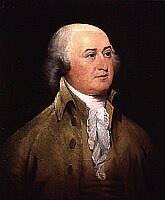
|
.
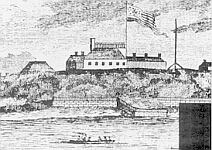 The first marine hospital
was located on Castle Island in Boston Harbor.
The first marine hospital
was located on Castle Island in Boston Harbor.
|
.v |
Special maritime hospitals were built, called marine hospitals.
There were 27 such hospitals at the start of the American Civil War. During
the war, some were seized by Confederate forces while others were converted
to different purposes, so that only eight remained by the end of the war.
Furthermore, the entire system of marine hospitals lacked central direction,
because control depended on various state and local circumstances. |
.
| Centralized direction dated from appointment of the first Surgeon
General (initially titled the "Supervising Surgeon of the Marine Hospital
Service") pursuant to an act reorganizing the Marine Hospital Service (16
Statute 170) on June 29, 1870.
This reorganization converted the system of hospitals, located primarily
in ports, into an improved service under Supervising Surgeon John Maynard
Woodworth, who was headquartered in the nation's capital. |
.v |
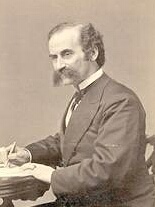
John M. Woodworth, Supervising
Surgeon from March 29, 1871 to March 14, 1879
|
.
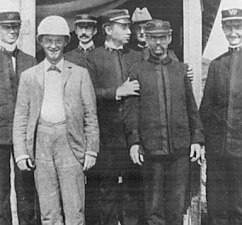 PHS officers in uniform
at the Montauk Point, New York, Quarantine Station,1898.
PHS officers in uniform
at the Montauk Point, New York, Quarantine Station,1898.
|
.v |
Woodworth placed his staff on a professional basis with military
uniforms and career pathways between the various marine hospitals. These
reforms resulted in the creation of the Commissioned Corps of the United
States Public Health Service during 1889.
The Commissioned Corps consisted only of doctors at first, but increased
its ranks over the next decades to contain engineers (of the sanitary services),
scientists, dentists, pharmacists, and nurses. |
.
The Marine Hospital Service increased its activities and began functioning
as a nationwide health service, instead of being limited to caring for
seamen. This expansion started with infectious disease control after the
1877 yellow fever epidemic, and then continued as quarantine responsibilities
were transferred from the states.
.
| Because of numerous outbreaks
of yellow fever in the gulf states in 1888, several yellow fever detention
camps were established by the Marine Hospital Service. The photograph shows
a camp that was built up in Florida near the Georgia border in 1888.
Persons who travelled from yellow
fever areas were required to remain in the camp for the incubation period
of 6-10 days before they were allowd to proceed. These controlls prevented
a further spread of the infection. |
.. |
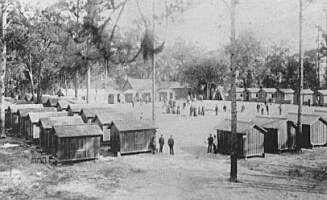 |
.
Next research, disease prevention and education were added. The
Service was redesignated as the Public Health and Marine Hospital Service
on July 1, 1902 (32 Statute 712), because of its greater public health
responsibilities.
.
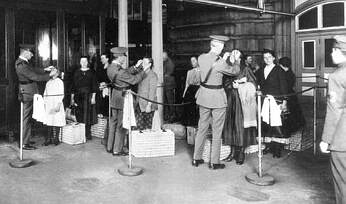
|
.. |
It was made madatory by an immigration
law of 1891 that Public Health Service physicians gave immigrants coming
into the United States a health inspection.
The physicians in the photograph
are looking at the eyes for signs of trachoma
(ca. 1910). |
..
The military role of the Service had proved important during the
Spanish-American War of 1898. As a result the 1902 act also provided: "That
the President is authorized in his discretion to utilize the Public Health
and Marine Hospital Service in times of threatened or actual war to such
extent and in such manner as shall in his judgment promote the public interest
without, however, in any wise impairing the efficiency of the Service for
the purposes for which the same was created and is maintained."
.
| In 1912 the Public Health and Marine Hospital Service was renamed
as the Public Health Service. New authority was given to deal with major
health issues, investigate diseases through field and laboratory research,
and improve disease-related conditions, such as sewage, sanitation, and
pollution. Medical cooperation to improve state and country health services
was improved. |
.v |
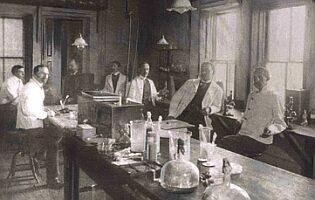
Scientists at work in the PHS
Hygienic Laboratory which was the forerunner of the National Institutes
of Health.
|
.
Public Health Service in World
War I
President Wilson "militarized" the Public Health
Service on April 3, 1917, just before America entered World War I. The
Service was utilized alongside the country's military forces, but not converted
into a military force. PHS stations and their staffs treated wounded and
sick service members, Public Health Service officers and officials were
detailed to the Army, Navy or Coast Guard as needed. A Congressional resolution
of July 9, 1917, confirmed the status of PHS officers while serving in
this manner.
.
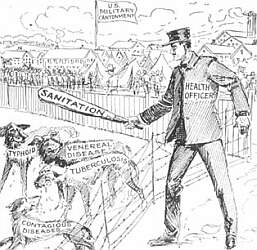 |
v |
During the actual war, most PHS commissioned
officers served on the home front, although a few were detailed to either
the Army or the Navy overseas.
The main task was keeping military training
areas within the United States safe from diseased conditions by close cooperation
with nearby health departments.
|
.
| Another major role was fighting venereal disease
and, in 1918, the Division of Venereal Disease was established.
For example, the PHS campaign
against venereal disease included the use of posters featuring a character
named PHS Surgeon Sage who warned soldiers against casual sexual encounters.
That same year all other efforts were overwhelmed
by the influenza pandemic, which demanded full attention. The PHS
was also given responsibility for care of all returning veterans. |
.v |
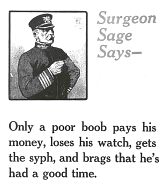 |
.
.
[ I. Development ]..[
II. Facts about the PHS ]..[
III. PHS Uniforms ]..[
IV. Sources ]
|
